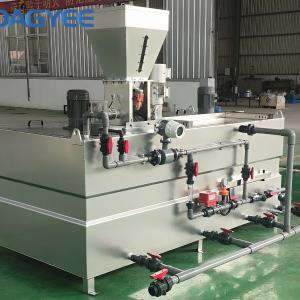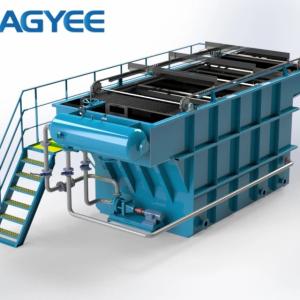DAGYEE Lamella Clarifier FAQ
Introduction to DAGYEE Solutions
About This Guide:
This document is designed to assist engineers, plant managers, and procurement specialists in understanding the technical advantages, operational principles, and customization possibilities of DAGYEE Lamella clarifiers. As a specialized manufacturer, DAGYEE focuses on tailoring clarification solutions to meet specific hydraulic and solids loading requirements.

Section 1: Fundamental Principles & Theory
Q1: What is a Lamella Clarifier, and how does it differ from a conventional settling tank?
A Lamella Clarifier (also known as an Inclined Plate Settler) is a compact water treatment unit designed to remove suspended solids from liquids.
· Conventional Clarifiers: Rely on a large horizontal surface area to allow particles to settle by gravity. This requires massive concrete tanks and a significant land footprint.
· Lamella Clarifiers: Utilize a series of inclined plates stacked closely together. This design multiplies the "effective" settling area by the number of plates used.
The DAGYEE Advantage: By using the Lamella principle, our units reduce the required physical footprint by up to 90% compared to traditional sedimentation tanks while treating the same flow rate.
Q2: How does the "Projected Surface Area" theory work?
The efficiency of any gravity settler is determined by its surface area, not its depth. In a Lamella clarifier, the total settling area is calculated based on the projection of the inclined plates onto a horizontal plane.
The formula for the Total Effective Settling Area ($A_{eff}$) is:
$$A_{eff} = N \cdot A \cdot \cos(\theta)$$
Where:
· $N$ = Number of plates
· $A$ = Surface area of a single plate
· $\theta$ = Angle of inclination (typically 55° or 60°)
Because DAGYEE stacks many plates vertically, we create a massive effective settling area within a very small tank footprint.
Q3: What is the mechanism of separation inside the DAGYEE Lamella unit?
The process relies on Stokes’ Law, but with a shortened settling distance:
1. Inlet: Water enters the unit and flows upward between the inclined plates.
2. Settling: Solid particles only need to fall a short distance (typically 50mm to 100mm, depending on plate spacing) to hit the surface of a plate.
3. Sliding: Once a particle hits the plate, it slides down the incline (due to gravity exceeding friction) and accumulates in the sludge hopper at the bottom.
4. Effluent: Clarified water continues upward, passes over weir plates, and exits the system.
Q4: Why is the plate angle usually set between 55° and 60°?
The angle is a critical design parameter that DAGYEE customizes based on the nature of your solids:
· 55° to 60°: This is the industry standard. It provides the "Self-Cleaning" effect. The angle is steep enough that solids slide down naturally without getting stuck, but shallow enough to maximize the projected surface area.
· < 45°: Sometimes used for thickening applications, but solids may require mechanical vibration to slide.
· > 60°: Reduces the effective settling area too much ($cos(60°) = 0.5$, meaning you lose 50% of the plate area to geometry).
Section 2: DAGYEE Customization & Engineering
Q5: Can DAGYEE customize the materials of construction?
Yes. As a manufacturer, DAGYEE offers complete material customization to suit the chemical aggression and temperature of your wastewater.
· Carbon Steel (Epoxy Coated): The most cost-effective solution for standard industrial wastewater with neutral pH. We use high-grade epoxy to prevent corrosion.
· Stainless Steel (SS304): Standard for food and beverage, potable water, and light chemical applications.
· Stainless Steel (SS316/316L): Mandatory for high-chloride environments (desalination, marine), acidic wastewater, or pharmaceutical applications to resist pitting corrosion.
· Plastic Construction (PP/PVC): For extremely corrosive environments (strong acids or electroplating baths) where metal cannot be used.
Q6: How do you determine the correct "Plate Spacing" for my project?
Plate spacing is not "one size fits all." DAGYEE adjusts this based on the size and stickiness of your suspended solids:
· 50mm Spacing: Ideal for fine, non-sticky solids (e.g., metal finishing, sand). Maximizes surface area.
· 80mm Spacing: Recommended for typical municipal wastewater or biological sludge.
· 100mm+ Spacing: Used for heavy, sticky, or large-particle applications (e.g., paper pulp, potato processing) to prevent clogging (bridging) between plates.
Q7: What types of Sludge Hoppers does DAGYEE offer?
The bottom of the clarifier is just as important as the plates. We customize the hopper based on sludge volume and density:
1. Pyramidal/Conical Hopper: Uses gravity only. The walls are steep (60°). Best for sludge that flows easily.
2. V-Bottom with Auger (Screw Conveyor): Best for heavy, dense sludge (like sand or metal grit) or high-volume sludge. The mechanical auger actively pushes sludge to the outlet.
3. Flat Bottom with Scraper: Used for very large, site-erected rectangular tanks.
Q8: Can DAGYEE integrate Flocculation and Flash Mixing tanks?
Absolutely. A Lamella Clarifier rarely works alone. For optimal performance, particles must be coagulated and flocculated before entering the plates.
· Integrated Unit: We can manufacture a monolithic unit where the Flash Mix (rapid mix) and Flocculation (slow mix) tanks are welded directly to the Lamella frame. This saves piping costs and installation time.
· Standalone Skids: We can also provide separate mixing skids if site constraints require a flexible layout.
Q9: What is "Laminar Flow" and how does DAGYEE ensure it?
For settling to occur, the water flow must be non-turbulent (Laminar).
· We utilize hydraulic modeling to ensure the Reynolds Number remains low (typically < 2000) between the plates.
· DAGYEE installs specific feed ports and baffles to distribute energy evenly, preventing "short-circuiting" (where water shoots through the tank without being treated).
Section 3: Sizing, Performance & Design Data
Q10: What information does DAGYEE need to size a Lamella Clarifier?
To provide a precise customized quote, we require:
1. Flow Rate: Maximum and Average ($m^3/hr$ or GPM).
2. TSS (Total Suspended Solids): Inlet concentration ($mg/L$ or ppm).
3. Target Effluent Quality: What is the required outlet TSS?
4. Particle Nature: Specific gravity, particle size, and stickiness.
5. Temperature & pH: Affects material selection and water viscosity.
6. Space Constraints: Dimensions available ($L \times W \times H$).
Q11: What is the typical "Hydraulic Loading Rate" (HLR)?
The HLR defines how much water passes through the projected surface area per hour ($m^3/m^2/hr$).
· Metal Hydroxides: 1.5 – 3.0 $m/hr$.
· River Water Silt: 3.0 – 5.0 $m/hr$.
· Biological Sludge: 0.5 – 1.0 $m/hr$ (lighter solids require slower rates).
DAGYEE engineers calculate the optimal HLR to ensure you do not undersize or oversize the unit.
Q12: What removal efficiency can I expect?
With proper chemical pre-treatment (coagulation/flocculation), DAGYEE Lamella Clarifiers typically achieve:
· >95% reduction in Total Suspended Solids (TSS).
· >90% removal of precipitated heavy metals.
· >70-80% reduction in COD/BOD associated with particulate matter.
Q13: Can this system remove oil and grease?
While Lamella Clarifiers are designed for sinking solids, they can be adapted. DAGYEE can install a surface oil skimmer and an adjustable weir to capture free-floating oil. However, for high oil loads, a DAF (Dissolved air flotation) system is usually a better choice. We can advise you on the best technology.
Section 4: Operational & Maintenance Questions
Q14: How is the sludge removed from the hopper?
Sludge removal can be automated or manual.
· Auto-Pumping: We recommend connecting the hopper outlet to a diaphragm pump or screw pump, controlled by a timer or a sludge blanket level sensor.
· Continuous vs. Intermittent: Heavy sludge loads require continuous withdrawal. Light loads allows for intermittent "blowdowns."
Q15: Does the DAGYEE Lamella Clarifier require power?
The settling process itself is passive (gravity-based) and requires zero power.
Power is only required for:
· The Flash/Floc Mixer motors (if integrated).
· The Sludge Auger drive (if selected).
· Pumps (feed and sludge discharge).
This makes the Lamella Clarifier an extremely energy-efficient solution.
Q16: How do I clean the plates if they get clogged?
Although the 55°-60° angle promotes self-cleaning, sticky solids can sometimes accumulate. DAGYEE designs for maintenance ease:
1. Top Access: Our units are open-top or have removable covers, allowing easy access to the plate packs.
2. Low-Pressure Wash: Operators can hose down the plates with service water from the top.
3. Removable Packs: In our smaller and medium-sized designs, the plate packs are modular and can be lifted out via crane for deep cleaning.
4. Optional Vibrators: For tenacious sludge, we can install pneumatic vibrators on the plate packs to shake loose solids.
Q17: What is the life expectancy of the plate packs?
· Stainless Steel Plates: Virtually indefinite lifespan under normal conditions.
· PVC/PP Plates: Typically 10–15 years, depending on UV exposure and chemical aggression.
DAGYEE ensures that all plate packs are supported by a robust frame to prevent collapsing or warping over time.
Q18: Can DAGYEE add a sludge thickener mechanism?
Yes. For clients wishing to increase the solids concentration of the underflow, we can integrate a picket fence thickener mechanism in the hopper. This slowly stirs the sludge, releasing trapped water bubbles and compressing the sludge to a higher density before discharge.
Section 5: Applications & Industries
Q19: Is the Lamella Clarifier suitable for potable (drinking) water?
Yes. DAGYEE manufactures units using NSF-grade or food-grade materials (SS304/316 and potable-grade PVC) suitable for municipal water treatment plants. They are excellent for removing silt, clay, and river turbidity.
Q20: How does this perform in the Mining and Aggregate industry?
This is one of our strongest applications. Mining wastewater contains heavy grit and sand.
· We use reinforced plate packs to withstand the abrasion.
· We recommend the V-hopper with heavy-duty Auger to handle the high density of the sludge/sands.
Q21: Can it be used for Biological Wastewater Treatment?
Yes, as a Secondary Clarifier. However, biological floc (bacteria) is light and fluffy. We design these units with lower Hydraulic Loading Rates and often use wider plate spacing to prevent the light floc from clogging the entry points.
Q22: What about Electroplating and Metal Finishing?
DAGYEE supplies many units to this sector. After chemically neutralizing the acid and precipitating the metals (Chrome, Nickel, Zinc), the Lamella Clarifier efficiently separates the metal hydroxides. We recommend PP (Polypropylene) construction for this industry to resist residual acid corrosion.
Section 6: Commercial, Logistics & Shipping
Q23: How does DAGYEE ship these units? Are they fully assembled?
We offer flexible shipping options based on unit size and destination:
· Small/Medium Units: Shipped fully assembled. You simply offload, connect pipes, and run.
· Large/Containerized Units: For export, we can design the unit to fit inside standard 40ft High Cube containers.
· Flat-Pack/Knock-Down: For massive systems, we manufacture the tank in bolted sections or prepare plate packs for installation into a concrete basin constructed on-site.
Q24: Do you provide control panels?
Yes. DAGYEE can provide a fully integrated Control Panel (PLC + HMI) to control:
· Feed pumps.
· Chemical dosing pumps (pH, Coagulant, Polymer).
· Mixer motors.
· Sludge discharge valves/pumps.
We can program the logic for "Set-and-Forget" automation.
Q25: Why should I choose DAGYEE over other manufacturers?
1. Customization: We do not force you into a standard catalog size. We build the tank to fit your specific flow and footprint.
2. Material Quality: We provide material certificates (Mill Test Reports) for all steel and plastics used.
3. Engineering Support: We provide 3D drawings, P&ID diagrams, and hydraulic calculations before production begins.
4. Cost-Effectiveness: As a direct manufacturer, we eliminate middle-man markups while maintaining international quality standards.
Q26: What is the lead time for a custom unit?
· Standard Design: 3 – 4 weeks.
· Custom/Large Scale: 5 – 8 weeks.
Lead times vary based on current factory load and material availability (e.g., exotic alloys).
Section 7: Troubleshooting Guide (Quick Reference)
Q27: Why is the effluent water cloudy (turbid)?
· Chemical Issue: The most common cause. Check your Coagulant/Flocculant dosing. Perform a Jar Test.
· Flow Surge: Are you exceeding the design flow rate?
· Sludge Carryover: The sludge hopper is full. Increase the sludge withdrawal rate immediately.
Q28: Why is flow coming out of only one side of the weir?
This indicates the unit is not level. Lamella clarifiers must be perfectly leveled during installation to ensure even flow distribution. If the unit is not level, water will take the path of least resistance, overloading one side of the plates and causing poor performance.
Q29: Floating sludge is appearing on the surface.
· Denitrification: In biological systems, nitrogen gas bubbles can form in the sludge, causing it to float. Increase sludge removal frequency.
· Oil/Grease: The inlet water has high oil content. Install a surface oil skimmer.
Glossary of Terms
· Flash Mixing: High-speed mixing to disperse coagulants.
· Flocculation: Slow mixing to build particle size.
· Supernatant: The clear liquid floating above the sediment.
· Underflow: The concentrated sludge removed from the bottom.
· Weir Loading Rate: The volume of water flowing over the outlet weir per unit length (important for preventing turbulence at the outlet).
· Short-Circuiting: When water bypasses the treatment area due to poor hydraulic design.
Ready to Customize Your Solution?
At DAGYEE, we believe every wastewater stream is unique. Contact our engineering team today with your water analysis and flow requirements, and let us design a Lamella Clarifier that fits your process perfectly.
- Company: Wuxi Dajiang Environmental Technology Co., Ltd. DAGYEE
- Phone/WhatsApp:+8613961861780
- Email: info@dagyee.com
- Website: www.dagyee.com






